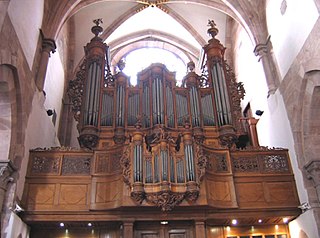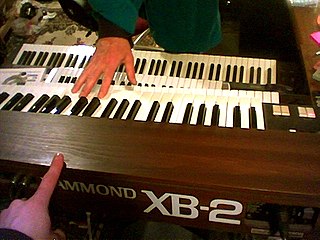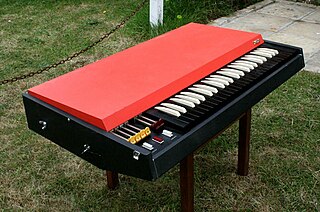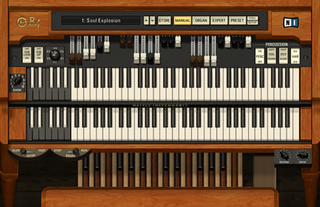
The Hammond organ is an electric organ invented by Laurens Hammond and John M. Hanert and first manufactured in 1935. Various models have been produced, most of which use sliding drawbars to vary sounds. Until 1975, Hammond organs generated sound by creating an electric current from rotating a metal tonewheel near an electromagnetic pickup, and then strengthening the signal with an amplifier to drive a speaker cabinet. The organ is commonly used with the Leslie speaker.

In music, the organ is a keyboard instrument of one or more pipe divisions or other means for producing tones, each played with its own keyboard, played either with the hands on a keyboard or with the feet using pedals.

The Leslie speaker is a combined amplifier and loudspeaker that projects the signal from an electric or electronic instrument and modifies the sound by rotating a baffle chamber ("drum") in front of the loudspeakers. A similar effect is provided by a rotating system of horns in front of the treble driver. It is most commonly associated with the Hammond organ, though it was later used for the electric guitar and other instruments. A typical Leslie speaker contains an amplifier, a treble horn and a bass speaker—though specific components depend upon the model. A musician controls the Leslie speaker by either an external switch or pedal that alternates between a slow and fast speed setting, known as "chorale" and "tremolo".
Farfisa is a manufacturer of electronics based in Osimo, Italy. The Farfisa brand name is commonly associated with a series of compact electronic organs and later, a series of multi-timbral synthesizers. Today, the Farfisa brand mainly produces intercom systems with the company ACI Farfisa which makes and distributes systems for video intercoms, access control, video surveillance, and home automation. The Bontempi group owns the keyboard division Farfisa brand name.

An electric organ, also known as electronic organ, is an electronic keyboard instrument which was derived from the harmonium, pipe organ and theatre organ. Originally designed to imitate their sound, or orchestral sounds, it has since developed into several types of instruments:

A manual is a musical keyboard designed to be played with the hands, on an instrument such as a pipe organ, harpsichord, clavichord, electronic organ, melodica, or synthesizer. The term "manual" is used with regard to any hand keyboard on these instruments to distinguish it from the pedalboard, which is a keyboard that the organist plays with their feet. It is proper to use "manual" rather than "keyboard", then, when referring to the hand keyboards on any instrument that has a pedalboard.

Bass pedals are an electronic musical instrument with a foot-operated pedal keyboard with a range of one or more octaves. The earliest bass pedals from the 1970s consisted of a pedalboard and analog synthesizer tone generation circuitry packaged together as a unit. The bass pedals are plugged into a bass amplifier or PA system so that their sound can be heard. Since the 1990s, bass pedals are usually MIDI controllers, which have to be connected to a MIDI-compatible computer, electronic synthesizer keyboard, or synth module to produce musical tones. Some 2010s-era bass pedals have both an onboard synth module and a MIDI output.

A stage piano is an electronic musical instrument designed for use in live performance on a stage or a studio, as well as for music recording in jazz and popular music. While stage pianos share some of the same features as digital pianos designed for home use and synthesizers, they have a number of features which set them apart. Stage pianos usually provide a smaller number of sounds, with these sounds being of higher quality, unlike regular digital pianos and home synthesizers.

Chord organ is a kind of home organ that has a single short keyboard and a set of chord buttons, enabling the musician to play a melody or lead with one hand and accompanying chords with the other, like the accordion with a set of chord buttons which was originated from a patent by Cyrill Demian in 1829, etc.

A clonewheel organ is an electronic musical instrument that emulates the sound of the electromechanical tonewheel-based organs formerly manufactured by Hammond from the 1930s to the 1970s. Clonewheel organs generate sounds using solid-state circuitry or computer chips, rather than with heavy mechanical tonewheels, making clonewheel organs much lighter-weight and smaller than vintage Hammonds, and easier to transport to live performances and recording sessions.

Clavia Digital Musical Instruments is a Swedish manufacturer of virtual analog synthesizers, virtual electromechanical pianos and stage pianos, founded in Stockholm, Sweden in 1983 by Hans Nordelius and Mikael Carlsson. Since 1995, Clavia's keyboards have been branded Nord.

The Nord Electro is a series of electronic keyboards, developed in Sweden by Clavia, that digitally emulate electro-mechanical keyboards, such as electric pianos and electronic organs, while designed to be highly portable.
The Nord Stage is a digital keyboard or stage piano, manufactured by Clavia Digital Music Instruments of Stockholm in Sweden. There have been five editions of the instrument; the original Nord Stage in 2005, the Nord Stage EX in 2008, the Nord Stage 2 in 2011, the Nord Stage 2 EX in 2015, and the Nord Stage 3 in 2017.

The Fender Contempo Organ is a combo organ made by Fender during the late 1960s. It was designed to compete with similar instruments such as the Vox Continental and Farfisa Compact, and was only in production for a few years.

The Vox Continental is a transistorized combo organ that was manufactured between 1962 and 1971 by the musical equipment manufacturer Vox. It was designed for touring musicians and as an alternative to the heavy Hammond organ. It supports drawbars in a similar manner to the Hammond, and has distinctive reverse-coloured keys. The sound is generated by a series of oscillators, using a frequency divider to span multiple octaves.
A combo organ, so-named and classified by popular culture due to its original intended use by small, touring jazz, pop and dance groups known as "combo bands", as well as some models having "Combo" as part of their brand or model names, is an electronic organ of the frequency divider type, generally produced between the early 1960s and the late 1970s. This type of organ predated, and contributed largely to, the development of modern synthesizers. The combo organ concept, at least in the context of mass-production, is thought to have arisen from popular demand, when smaller home organs were seen in music stores. Combo organs were probably originally developed in the United Kingdom, based on the Univox polyphonic version of the Clavioline, and some models included the inner-workings of Italian-made transistor accordions. They were the brainchild of necessity for portable organs of simple design, mainly for use in these small groups. Combo organs ended up having a major impact on the music scene of the mid- and late 1960s, particularly on rock and roll of that era.

The Roland VK-7 is an electronic keyboard introduced in 1997 which simulates the sound of an electromechanical Hammond organ. Like other electronic musical instruments that emulate the sound of the electromechanical tonewheel-based organs formerly manufactured by Hammond, the VK-7 is referred to as a clonewheel organ. Currently it is replaced by the VK-8 and the VK-88.

The B4 Organ II is a discontinued commercial, proprietary software synthesizer made by Native Instruments. The software runs as a stand-alone executable, or as a VST, DXi, or RTAS plugin in a Digital audio workstation. The software is an example of a "Clonewheel organ", an attempt at recreating the sound of a Hammond organ using software synthesis.
The Korg CX-3 is a clonewheel organ that simulates the sound of an electromechanical Hammond organ and Leslie speaker. The CX-3 was first introduced in 1979.
















